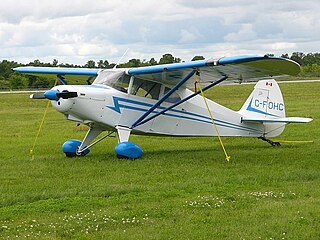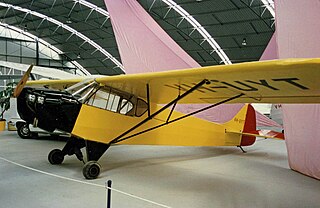
The Piper PA-28 Cherokee is a family of two- or four-seat light aircraft built by Piper Aircraft and designed for flight training, air taxi and personal use. The PA-28 family of aircraft comprises all-metal, unpressurized, single-engined, piston-powered airplanes with low-mounted wings and tricycle landing gear. They have a single door on the copilot side, which is entered by stepping on the wing.

The Piper PA-24 Comanche is an American four-seat or six-seat, low-wing, all-metal, light aircraft of semi-monocoque construction with tricycle retractable landing gear. Piper Aircraft designed and developed the Comanche, which first flew on May 24, 1956. Together with the PA-30 and PA-39 Twin Comanche, it made up the core of the Piper Aircraft lineup until 1972, when the production lines for both aircraft were wiped out in a flood.

The Piper J-3 Cub is an American light aircraft that was built between 1937 and 1947 by Piper Aircraft. The aircraft has a simple, lightweight design which gives it good low-speed handling properties and short-field performance. The Cub is Piper Aircraft's most-produced model, with nearly 20,000 built in the United States. Its simplicity, affordability and popularity invokes comparisons to the Ford Model T automobile.

The Piper PA-15 Vagabond and PA-17 Vagabond are both two-seat, high-wing, conventional gear light aircraft that were designed for personal use and for flight training and built by Piper Aircraft starting in 1948.

The Piper PA-34 Seneca is an American twin-engined light aircraft, produced by Piper Aircraft since 1971 and that remains in production. The Seneca is primarily used for personal and business flying.

The Piper PA-18 Super Cub is a two-seat, single-engine monoplane. Introduced in 1949 by Piper Aircraft, it was developed from the Piper PA-11, and traces its lineage back through the J-3 to the Taylor E-2 Cub of the 1930s. In close to 40 years of production, over 9,000 were built. Super Cubs are commonly found in roles such as bush flying, banner towing and glider towing.

The Piper PA-16 Clipper is an extended fuselage model of the PA-15 Vagabond. Both models were designed in 1947 for the same reason – Piper Aircraft found itself in dire financial straits and needed to create new, competitive models using existing parts and tooling. The result was the Vagabond, essentially a side-by-side version of the tandem J-3 Cub credited with saving the company.

The Piper PA-12 Super Cruiser is an American three-seat, high wing, single-engine conventional landing gear-equipped light aircraft that was produced by Piper Aircraft between 1946-48. The PA-12 was an upgraded and redesignated Piper J-5.

The Piper J-4 Cub Coupe is a two place side-by-side version of the Piper J-3 that was built between 1938 and 1942 by Piper Aircraft. It was Piper's first model with side-by-side seating; combined with docile low-speed handling, this made it a good trainer.
The Piper PA-8 Skycycle was a 1940s American single-seat light aircraft designed and built by Piper Aircraft at their Lock Haven, Pennsylvania plant. Towards the end of 1944 Piper announced a number of aircraft it intended to build after the war. One of these was the PWA-8. An aerodynamic test aircraft was built with the name Cub Cycle and it first flew on 27 August 1944 with a small two cylinder Franklin engine. The Franklin engine was replaced by a 37 hp (28 kW) Continental A-40-3 and the aircraft first flew with the Continental engine on 12 September 1944. The Skycycle was a fabric-covered mid-wing single-engined single-seat monoplane with a tailwheel landing gear. The fuselage was produced using a belly fuel tank as used on the F4U Corsair. The Cub Cycle was scrapped and a similar but new aircraft was built with the name Skycycle. The Skycycle first flew on 29 January 1945 using the same Continental engine as the Cub Cycle. The aircraft was further modified in 1945 with a 55 hp (41 kW) Lycoming O-145-A2 engine and designated the PA-8 Skycycle. No further examples were built.
The Piper PA-7 Skycoupe was a 1940s American two-seat light aircraft designed and built by Piper Aircraft at Lock Haven. Towards the end of 1944 Piper announced a number of aircraft it intended to build after the war. One of these was the PWA-1 Skycoupe. A prototype was built in 1943, it was a two-seat side-by-side low-wing cantilever monoplane with a twin-boom fuselage with a tricycle landing gear. It had a Franklin 4ACG-199-H3 engine driving a pusher propeller. In 1945 it was redesignated the PA-7 Skycoupe but no further examples were built.
The Piper PA-6 Sky Sedan was a 1940s American four-seat light aircraft designed and built in prototype form by Piper Aircraft at its Lock Haven, Pennsylvania, factory.

The Piper PT-1 was a 1940s American two-seat primary training monoplane designed and built by Piper Aircraft at Lock Haven. A low-wing tandem two-seat monoplane, the PT-1 was the first Piper aircraft to have a low-wing. It had a fabric covering over an all-metal fuselage frame and wooden spar wings and tail unit. The PT-1 had a retractable tailwheel landing gear and was powered by a 130 hp (97 kW) Franklin 6AC-2980D engine. No further aircraft were built. A four-seat development was designed as the Piper PWA-6 which did not go into production either.

The Taylor J-2 Cub is an American two-seat light aircraft that was designed and built by the Taylor Aircraft Company. The company became the Piper Aircraft Company and the J-2 was first of a long line of related Piper Cub designs.

The Piper PA-35 Pocono was an American 16/18 seat commuter airliner developed by Piper in the late 1960s. Only one aircraft was built and the design was not developed.
The Piper PA-29 Papoose was an American single-engined training monoplane designed by Piper, only one was built and the type did not enter production.
The Avid Champion is an American single-seat, high-wing ultralight aircraft that was produced starting in 1998 as a kit by Avid Aircraft of Caldwell, Idaho, later Ennis, Montana.
The Light Miniature Aircraft LM-1, LM-2 and LM-3 are a family of American high wing, conventional landing gear, strut-braced, single engine ultralight aircraft that are scale reproductions of famous general aviation aircraft. The designs were all available as plans from Light Miniature Aircraft of Okeechobee, Florida for amateur construction.
The Coupé-Aviation JC-01 is the first of a series of very similar designs of two seat, single engine sports aircraft, amateur built from plans in France from 1976. These provided a range of engine sizes and undercarriage layouts, but total production was small.




















